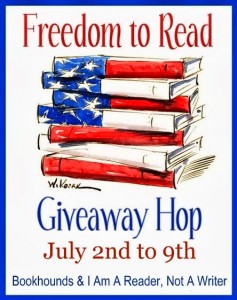 Welcome to my blog! The week of 2 July – 9 July, I’m participating with more than one hundred other bloggers in the “Freedom to Read” giveaway hop, accessed by clicking on the logo at the left. All blogs listed in this hop offer book-related giveaways, and we’re all linked, so you can easily hop from one giveaway to another. But here on my blog, I’m posting a week of Relevant History essays, each one focused on some facet of the American War of Independence. To find out how to qualify for the giveaways on my blog, read through each day’s Relevant History post below and follow the directions. Then click on the Freedom Hop logo so you can move along to another blog. Enjoy!
Welcome to my blog! The week of 2 July – 9 July, I’m participating with more than one hundred other bloggers in the “Freedom to Read” giveaway hop, accessed by clicking on the logo at the left. All blogs listed in this hop offer book-related giveaways, and we’re all linked, so you can easily hop from one giveaway to another. But here on my blog, I’m posting a week of Relevant History essays, each one focused on some facet of the American War of Independence. To find out how to qualify for the giveaways on my blog, read through each day’s Relevant History post below and follow the directions. Then click on the Freedom Hop logo so you can move along to another blog. Enjoy!
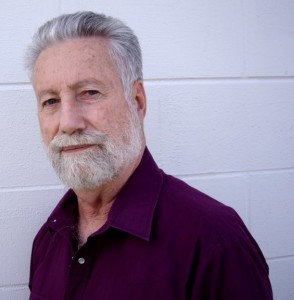 Relevant History welcomes Jack Parker, who was born in Pennsylvania, raised in Delaware, and has lived in Virginia, California, Colorado, and South Carolina. He earned a Bachelors Degree in Education and served four years in the U.S. Navy as an Asst. Navigator aboard the USS Spiegel Grove, then as Navigator and Executive Officer aboard the USS Pitkin County. After leaving the Navy, he moved to Colorado, rode and packed horses into the Gunnison Wilderness Area. He then spent five years living aboard a 43-foot yawl home ported in Charleston, SC, and taught several people to sail and live on the water. For more information, and to purchase Parker’s Guide to the Revolutionary War in South Carolina, check his web site.
Relevant History welcomes Jack Parker, who was born in Pennsylvania, raised in Delaware, and has lived in Virginia, California, Colorado, and South Carolina. He earned a Bachelors Degree in Education and served four years in the U.S. Navy as an Asst. Navigator aboard the USS Spiegel Grove, then as Navigator and Executive Officer aboard the USS Pitkin County. After leaving the Navy, he moved to Colorado, rode and packed horses into the Gunnison Wilderness Area. He then spent five years living aboard a 43-foot yawl home ported in Charleston, SC, and taught several people to sail and live on the water. For more information, and to purchase Parker’s Guide to the Revolutionary War in South Carolina, check his web site.
*****
South Carolina was a leader in the Revolutionary War with many battles, skirmishes and murders. Parker’s Guide to the Revolutionary War in South Carolina was written to put the location with the “what happened there” for the actions in South Carolina, to educate those that believe the war was fought and won in the north. South Carolina was in the forefront of the war and the founding of our nation from the beginning.
The second edition of Parker’s Guide is the most complete publication on the Revolutionary War in South Carolina. The little-known events of the war in South Carolina are related here to inform everyone about the contribution of South Carolina in winning the Revolution.
One issue dividing the colonies from their motherland was that the British government required tax stamps for imported goods. On 18 October 1765, the ship Planters Adventure delivered the stamps to Fort Johnson, on James Island, where they were stored. The HMS Speedwell was stationed close to the fort on 23 October to deter an angry mob of citizens from Charleston. Two days later, the mob boarded the Carolina Packet that was thought to be carrying more stamps and the stamp officer, Mr. George Saxby, but he was not due until the next day. On 26 October, the Heart of Oak (built in Mt. Pleasant, SC) sailed into the harbor with Mr. Saxby aboard. That night, 150 volunteers from Charleston, commanded by Col. Daniel Stevens, captured twelve guards and a sergeant and took over the fort with the stamps. Upon the Speedwell sighting the “Liberty” flag of Patriot Christopher Gadsden instead of that of the British, a party was sent to the fort, where they were told the stamps must be removed from the fort and the province or they would be burned. Believing the Americans would not be deterred, the Speedwell removed the stamps and sailed out of the harbor. This action is often overlooked because it is prior to the Revolution’s accepted starting date, but is significant since it relates to the stamp problems in New England.
A Patriot, Dr. John Haley, killed Peter DeLancey, a prominent New York Tory, in a duel at a Charleston tavern. Before and during the Revolution, many notable Charlestonians met to drink and discuss politics at McCrady’s Tavern. DeLancey came to Charleston in 1771 and may have been killed over politics or a woman. The reason for his killing is unknown.
Peter DeLancey was the son of New York Royal Lt. Gov. James DeLancey. The killing of Peter DeLancey in Charleston resulted in Loyalist Brig. Gen. Oliver DeLancey raising and commanding a provincial regiment (three battalions), known as DeLancey’s Brigade of light horse troops to fight the South Carolina Patriots in 1776.
In 1775, the arms stored in the attic of the State House by the British were seized by the Americans. This was the scene of the first significant incident of the Revolutionary War in South Carolina. This incident happened just two days after Patriots fired on the British at Lexington, Massachusetts.
The war was used as an excuse for robbery and violently settling disputes. The Harrison Brothers plundered the Patriots to enrich themselves with the blessing of the British forces. The Tories on Lynches Creek, in the vicinity of M’Callum’s Ferry, began their murders and depredations early in the war. Matthew Bradley, Thomas Bradley, and John Roberts, all respectable and upstanding citizens who had joined neither party, were murdered in their homes, possibly with some other members of the Salem Black River Presbyterian Church congregation. The three Harrison brothers joined the local Tories; John Harrison later became a major and Samuel became a captain of the “South Carolina Rangers” in the British provincial service. British Lt. Col. Banastre Tarleton called them “men of fortune.” They were three of the worst bandits of the area. Before the fall of Charleston to the British, they lived in a wretched log hut by the road near M’Callum’s Ferry over the Lynches Creek (River), just east of modern Bishopville, SC. As an example of the recriminations and civil war, the Americans killed Robert Harrison in his home. After the war was over, the major retired to Jamaica as a rich man with the wealth accumulated from looting Patriots’ homes and robbing his neighbors.
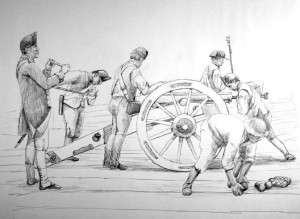 Within four months after Gen. Nathanael Greene’s return to South Carolina, his Southern Continental Army, with South Carolina, North Carolina, and Virginia state troops and militia, broke the British hold on the interior by eliminating the Crown’s posts one by one. American mounted detachments carried the war almost to the gates of Charleston. A decisive blow was dealt to the British on the battlefield at Eutaw Springs in September of 1781.
Within four months after Gen. Nathanael Greene’s return to South Carolina, his Southern Continental Army, with South Carolina, North Carolina, and Virginia state troops and militia, broke the British hold on the interior by eliminating the Crown’s posts one by one. American mounted detachments carried the war almost to the gates of Charleston. A decisive blow was dealt to the British on the battlefield at Eutaw Springs in September of 1781.
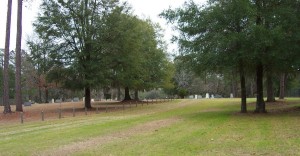 Eutaw Springs was essentially a draw, but the battle was both a material and moral victory for the Americans. The British suffered such heavy losses that they could no longer exert control beyond Charleston and its immediate environs. The British troops at Eutaw Springs were to reinforce Lord Cornwallis at Yorktown, but because of their heavy losses in this battle, they retreated to Moncks Corner and to White’s Meeting House (Dorchester County) to recover. Since the British in the Battle of Eutaw Springs were unable to reinforce Cornwallis, he was defeated.
Eutaw Springs was essentially a draw, but the battle was both a material and moral victory for the Americans. The British suffered such heavy losses that they could no longer exert control beyond Charleston and its immediate environs. The British troops at Eutaw Springs were to reinforce Lord Cornwallis at Yorktown, but because of their heavy losses in this battle, they retreated to Moncks Corner and to White’s Meeting House (Dorchester County) to recover. Since the British in the Battle of Eutaw Springs were unable to reinforce Cornwallis, he was defeated.
The war in South Carolina did not end with the surrender of Cornwallis, but continued until September 1783. It is generally thought that the War in SC ended when the British withdrew from Charlestown in December 1782, but there were some murders and retributions thereafter. The final act of revenge for the war was carried out in 1807 with the shooting of “Ned Turner,” one of William “Bloody Bill” Cunningham’s right hand men, by John and William, sons of Stokely Towles who was killed by Ned Turner on 18 November 1781.
*****
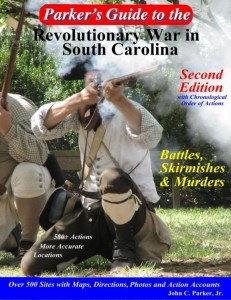 A big thanks to Jack Parker. He’ll provide a $10.00 discount certificate toward the purchase of a copy of Parker’s Guide to the Revolutionary War in South Carolina for someone who contributes a legitimate comment on this post today or tomorrow. Delivery is available worldwide. Make sure you include your email address. I’ll choose one winner from among those who comment on this post by Wednesday 9 July at 6 p.m. ET, then publish the name of all drawing winners on my blog the week of 14 July. And anyone who comments on this post by the 9 July deadline will also be entered in the drawing to win a copy of one of my five books, the winner’s choice of title and format (trade paperback or ebook).
A big thanks to Jack Parker. He’ll provide a $10.00 discount certificate toward the purchase of a copy of Parker’s Guide to the Revolutionary War in South Carolina for someone who contributes a legitimate comment on this post today or tomorrow. Delivery is available worldwide. Make sure you include your email address. I’ll choose one winner from among those who comment on this post by Wednesday 9 July at 6 p.m. ET, then publish the name of all drawing winners on my blog the week of 14 July. And anyone who comments on this post by the 9 July deadline will also be entered in the drawing to win a copy of one of my five books, the winner’s choice of title and format (trade paperback or ebook).
**********
Did you like what you read? Learn about downloads, discounts, and special offers from Relevant History authors and Suzanne Adair. Subscribe to Suzanne’s free newsletter.

The “Wild West” wasn’t as far west as we believed.
Jack’s book has maps, GPS locations and a narrative about the events listed. It is a one-of-a-kind, complete review of murders, skirmishes and battles. It is not only informative but interesting reading. Every Rev War buff should have it to peruse. It is habit forming! Great job!
It’s the best guide to the Rev War in South Carolina, regardless of whether you are a casual tourist, a local resident, an armchair reader, or an historical researcher. I echo Dr. Swager’s assessment.
I knew that South Carolina was a hotbed of violence during the Revolution, but I did not realize just how much of it was apparently just opportunistic. Thanks for a very informative article, and for your diligent research into this little-known aspect and region of the war!
The last set battle in the north between British and American troops was The Battle of Monmouth Courthouse in July 1778! From that point on the battles were all in the south and Lord Cornwallis approached Yorktown after over a year slugging it out in the Carolinas and taking huge casualties. From the capture of Charleston in May, until the Defeat of Gates at Camden in August, there were more than 2 dozen (Jack may have identified more)skirmishes in the Back Country where patriot militia mauled Provincials. Between Camden and Cowpens there were dozens more. To understand what was going on in the south, the best reference is John Buchanan’s book, The Road to Guilford Courthouse. He is presently writing the sequel which will cover Greene’s campaign to take back the south. Greene accomplished it by pushing the British back to Charleston 5 weeks before Yorktown.
Several Rev. War researchers did a study of the total number of known actions in the war and determined that approximately 1/4 of them happened in South Carolina. In the north, large armies did most of the fighting. The British decided to move the war south to divide the colonies, but the actions of the British there turned more and more South Carolina citizens against them. In the south, small militia groups were fighting in many different areas of the state at the same time, many using the guerilla hit and run tactics of Francis Marion.
Jack did a great job researching and locating the many engagements, big and small, in SC. As shown in this interesting essay, the writing and editing makes “Parker’s Guide to the Revolutionary War in South Carolina” a fine reference document for anyone interested in the Revolutionary War.
Two or three of my ancestors turned out to be Tories who fled South Carolina during this period. I’ll look forward to reading this book.
Brenda, There was a period sequestration in South Carolina during the war about 1780 when the Patriots rounded up the wives and children of Tories. Their cattle, other farm animals and property were seized for use by the Patriots. The wives and children were sent to Charleston to be deported with the British forces when they abandoned Charleston and South Carolina. Your relatives may have been part of the sequestration. However, many Tories just departed South Carolina to somewhere safe, like East Florida.
Thanks! Sheds light on why so many of my relatives were once in South Carolina and did not stay….
In one case the father voluntarily donated to Patriot cause I believe from the records I’ve read but his son (also my ancestor) fled to Mississippi.
One ancestor got here with his own cannon and you are reminding me why he thought he needed one!
Sadly, Jack, not all of them made it to East Florida: http://www.floridatoday.com/story/news/local/2014/06/30/florida-frontiers-american-revolutions-past-surfaces/11828193/
(I’m planning a future novel around these tragic events…)
Lars, thank you for the excellent link. As I’m a Florida native, I enjoy learning information like this.
Lars, Thank you for the article about the 1782 St. Augustine naval disaster. I will try to locate the original reference documents and pass them on to other researchers in SC. I did not know what happened to the ships that departed Charleston in 1782. Now I know what happened to some of them.
Jack, for the purposes of my novel, I’m most interested in the ships that left, and any information at all about their passengers. I tend to focus on fictional characters, rather than individuals known to history, but I devour as much primary source material as possible in order to lend my characters verisimilitude.
I would be most grateful for anything you might be able to point me towards!
Let me add my recommendations for at least the first edition of Parker’s Guide. A wonderful book indeed. And very useful in finding “lost” battlefields, such as Hanging Rock, which I remember seeing when it was clearly marked.
Once, I wrote an web article on a SC church with the same name as a battle site – and ended up later writing an article on that battle, as most of the hits I got were from folks wanting info on that battle – and at the time there was nothing else on the web. So a lot of folks out there looking for information, glad to have more out there.
Lars, I will let you know if I turn up anything on the British depart from Charleston in 1782. There may be some documents from the British side.
Another fascinating and informative post regarding the war in South Carolina. The Harrison brothers information was particularly intriguing and would make a great premise for a novel…